Beaudesert Boys School Leighton Buzzard

The original Boys' School building of 1813 seen in 1913 [Z50/72/21]
In 1812 the Leighton Buzzard Society of Friends (Quakers) decided to establish a Lancasterian School in the town. The building was opened in 1813 in Beaudesert. The Society for Promoting the Lancasterian System for the Education of the Poor had been established in 1808, changing its name to the British and Foreign Schools Society in 1814, from which point the schools became known as British Schools. The Society promoted schools run along the lines pioneered by Joseph Lancaster, who had himself copied those of Dr.Andrew Bell, in which older children taught their younger fellows. The Society was supported by a number of prominent nonconformists, Lancaster himself was a Quaker, and sought to teach a non-sectarian curriculum in direct challenge to the Church of England's existing schools.
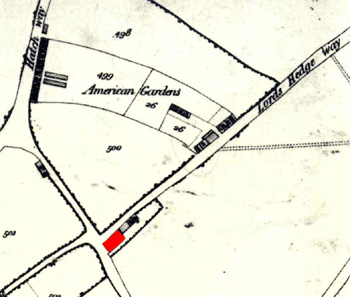
The British School in 1819 in red
The site of the school had been conveyed by Edward Ashwell to John Peppiatt for ten shillings in 1758 at which time it was described as half an acre of arable land in Shenley Hill Field next to Little Hunts Way with the "barn and buildings" standing on it [SB26/2/1]; the deed does not state why the sum was so low, one can only speculate either that the two men were related or that Ashwell may have owed Peppiatt money. Peppiatt conveyed the plot to Thomas Tring, baker, in 1760 for £40 [SB26/2/2]. The trustees of Thomas Tring's estate under his will conveyed the plot to William Tring, baker in 1794 for £200 [SB26/2/4]. Seven years later Tring conveyed the land to Thomas Brown, baker, for £50 [SB26/2/5], again there is no explanation for the small sum involved.
In 1808 Thomas Brown conveyed the "newly erected cottages or tenements situate and being near a certain place called America Row in Shenley Hill Field, next Hunts Highway" together with garden ground forming part of the half acre and barns and buildings standing on the remainder of the half acre he had purchased from William Tring in 1801 to Richard Rolfe, grocer, for £180 [SB26/2/6]. Rolfe conveyed the cottages, barns and land to his mortgagee, John Deverell of Rock Lane, Soulbury [Buckinghamshire], dairyman for £260 in 1810 [SB26/2/12]. Three years later, in April 1813, Deverell conveyed the three cottages land their garden ground, but not the remaining part of the original half acre, to Joseph Sharples, banker, for £200[SB26/2/13].
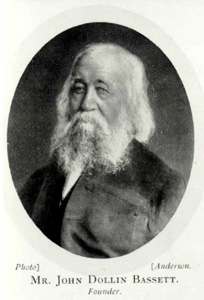
John Dollin Bassett [Z50/72/23]
Following the opening of the school Sharples conveyed the site and the buildings, described as "a messuage or tenement or school house , cottages, pieces or parcels of ground" to the to the Quaker trustees: Charles Pettit, lace manufacturer, John Dollin Bassett, banker, Richard Sanders, grocer, Joshua Sharples, farmer, Francis Hill Gregory, currier, Robert Thorp, draper, John Grant, banker, John How, corn dealer, Edward Lawford, wharfinger, Gregory Odell Clarke, gentleman, William Exton, banker, Thomas Wagstaff, surgeon, William Robinson Lawford, surgeon, James Sanders junior, mason, Abraham Mann, farmer, William Chew, miller and Samuel Reeve, grocer for the nominal sum on ten shillings [SB26/2/15]. The tenants of the former cottages, John Birdsey, Daniel Nickolls and Thomas Barns had thus been rendered homeless; the deed, naturally, does not state what happened to them.
Bedfordshire & Luton Archives & Records Service has a hand written invitation to the opening of the new school from John Grant to Bedfordshire Member of Parliament Samuel Whitbread II, a founding member of the Lancasterian Society [W1/856], it reads: "We are about to Establish a School here on the Lancasterian plan. The Building is Already erected and sufficient to accommodate Two Hundred Boys. We have a meeting appointed for opening on Friday the 10th Sep at Ten o'clock, to be held in the School room. Joseph Cox Esquire the Secretary to the Lancasterian Institution in London will attend, to give an explanatory Lecture on the System of Education &c. &c. Our Committee have requested that I would ask the favour of thy Attendance on the Occasion to take the Chair, fully persuaded thy presence will most materially promote the interest of the Institution. We shall be obliged by they Answer by return of post, as it will be necessary to give Notice of the intended meeting, by some printed Hand Bills".
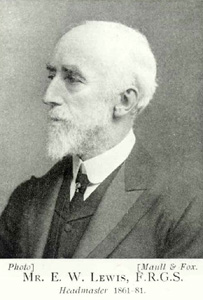
E.W.Lewis Headmaster 1861 to 1881 [Z50/72/30]
In March 1893 a School Board was formed in Leighton Buzzard which took over the running of the British School, henceforth known as a Board School. By this time there was need for a second infants' school in the town to augment the school in Bassett Road which had been open since 1839. It was decided to use the 1813 built boys' school premises for the infants which, after enlargement and alteration could accommodate 300. This school lay on the corner of Beaudesert and East Street (as Hunts Highway, later Lords Hedge Way was renamed).
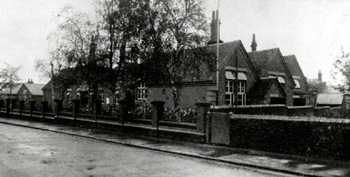
Beaudesert Boys' Council School in 1913 [Z50/72/21]
The new Board Boys' School, built in the same year as the reorganisation could accommodate 270. It lay on an adjacent plot on the east side of Beaudesert extending as far down as opposite the junction with Lammas Walk. The plot, with another small plot adjoining, was conveyed by Charles Ridgeway, draper to Henry Pettit, gentleman in 1871 for £234 and was described as a plot of 1,367 square yards in Vandyke Furlong, with a frontage to Windmill Road [now called Beaudesert] of 114 feet and having a barn on it [SB26/2/24]. Later that same year Pettit sold the plot to Edward Pettit of London for £205 [SB26/2/26]. Edward Pettit conveyed this land to the Leighton Buzzard School Board on 3rd April 1894 for £220.
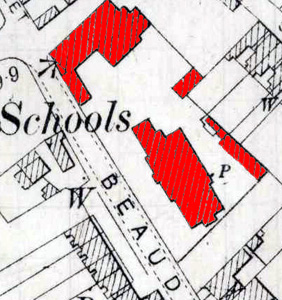
Beaudesert School buildings in 1901 in red
The Education Act of 1902 abolished School Boards, replacing them with a Local Education Authority which, for Bedfordshire, was Bedfordshire County Council. Thus board schools became known as council schools. Bedfordshire & Luton Archives & Records Service has a scrapbook of cuttings of visits made to most Bedfordshire Schools by School Inspectors for a period from just before the First World War through the inter-war years [E/IN1/1].
The first inspection of the school in the volume came in 1912, when average attendance was 277. The inspector stated: "This School continues increasingly to deserve the high reputation it has enjoyed for so many years. Instruction is sound and intelligent throughout while tone and discipline are quite excellent. The Head Master spares himself in no way but continually interests himself , not only in the scholars at the time in his School, but also in those who have left and gone out into the world". The only criticism he could make was: "I must point out that the premises used for Manual Instruction are most unsatisfactory". The inspector made a plea for more assistance to Head and staff in case they got over-stretched given the large number of boys at the school.
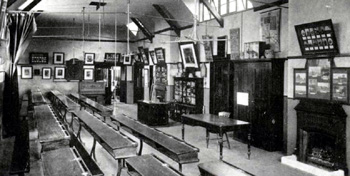
Beaudesert Boys' Council School interior in 1913 [Z50/72/21]
Next year the inspector reported: "Satisfactory progress is being made and it is confidently anticipated that the methods of instruction now adopted will have the effect of increasing the interest in the work and of considerably raising its educational value". However: "The temporary shed used as a workshop is quite unsuitable for the purpose: in winter it is extremely cold, in summer unbearably hot".
Unusually there is a note of a brief inspection carried out during World War One: "In contravention of Article 14 of the Code, the numbers of scholars on the registers of the fourth and fifth classes were 63 and 67 respectively". The first inspection after the war came in 1921, when average attendance was 292. The report began: "The Head Teacher of this School continues to do excellent work in fostering the spirit of "esprit de corps" sportsmanship and courtesy for which the School is well-known. He is backed up by the Old Boys, as is evident from the beautifully conceived and splendidly executed War Memorial, the Picture Gallery, and the photographs of all the old scholars who have risen to distinction in business, and in civil or parliamentary administrative work. The School song, too, and the position of responsibility give to the School Captain, all help this side of the work which deserves very high praise". The inspector went on, after praising the work of Head Teacher and staff: "but the time has come when the recommendation made in the report of 1912 that more assistance should be provided should be seriously considered by the Authority. This is the more urgent as the Certificated Assistant, who was then working part time, has left and he has not been replaced".

William Sinclair Currie Headmaster 1891 to 1929
The next visit, in 1925, average attendance 292, noted: "This is a thoroughly well conducted school with an excellent tone". In 1929 it was noted: "The Head Master who retires this month has done many years excellent work in this school. The work has always been genuine and successful: and his boys and Old Boys have acquired a remarkable Esprit de Corps which shows itself in many ways. He has also, as Teacher's Representative on the Education Committee, done service to the county of very great value. In both capacities - as Head of this important school and as adviser in Committee - his abilities and sound sense will be greatly missed".
The final report of the school came in 1930, when average attendance was 284. It began: "This is an interesting School. The premises unfortunately, are not large enough to contain all the boys who should attend, and the effect of the "bulge" years are beginning to be felt". The report went on: "In spite of these difficulties, the Head Master is doing excellent work, whichever aspect - organisation, curriculum, examination, or experiment - is considered: the staff have responded very well. To use the Master's own phrase, they are working splendidly as a Team. It was not easy to succeed the late Head: but the traditions he established have been followed, and the responsibility of the monitors, and their share in helping to govern the School's activities in sport and other directions, has been maintained, or even extended. The part the staff also play in the out of School life of the boys deserve special mention. In view of the uncertainty of the organisation and changes in staff since the present Head took office, it is not proposed to make a detailed report on the work, except to say that it is very satisfactory, that a proportion of boys go on to Secondary Schools, and that two developments are worth noting. In order to carry on the preparation for after life [!], more use has been made of debates and lectures by the boys themselves. This has had a good effect in School on the form of which replies to questions are made: in fact at the visit in December this clearness of response gave the first indication of the training to the Inspector. The other development is also having its effect. One of the staff gave a course of very successful lessons in French to a class of volunteers; this has led to a greatly increased attendance of enthusiastic ex scholars for French at the Evening School".
On 1st April 1933 the school was reorganised as a Senior Boys' Council School, catering for boys aged eleven and over. The school logbook [SDLeightonBuzzard1/4] notes that the school had contained 308 boys, of whom 8 left at Easter; 122 juniors were transferred to Pulford's Public Elementary School and 48 seniors transferred in from that school, leaving the number on the roll of the new school as 227. The names of the staff are given as E.A.Muskett (Form 3A), A.E.Parker (Form 3B), H.Hawkin (Form 2A), E.W.Wallbank (Form 2B), W.P.Wiseman (Frm 1A) and Mrs.E.Baker (Form 1B).
This school continued until 1946 when the Education Act 1944 came into force and the school was reorganised as Beaudesert County Secondary Modern School. Secondary Moderns were designed for the 75% of pupils who did not achieve top marks in the Eleven Plus examination, the top 25% going to a Grammar School which, in Leighton Buzzard, meant Cedars School. A Secondary Modern taught a more skills based curriculum, intended to fit pupils for a life of work whereas in the Grammar School emphasis was placed on more academic subjects with a view to pupils going on to attend university. In January 1959 Beaudesert CSM merged with the equivalent school for girls in the town in Bassett Road and the merged school met in new purpose built premises in Brooklands Drive and was known as Brooklands County Secondary Modern School.

The site of the 1813 Beaudesert School December 2008
The old Beaudesert site was used by the adjoining Beaudesert County Primary Infants' School, which became Beaudesert Lower School in the 1970s under comprehensive reorganisation. This school moved to new premises in Appenine Way in 1981 and the buildings and sites of both Beaudesert schools were sold to McCann Homes for Redevelopment as housing for £1,500.

The site of Beaudesert Infants School December 2008
Sources
- SB26/2/1-26: deeds: 1758-1871;
- W1/856: invitation to the opening of the school: 1813;
- X1/34: map showing the school: 1819;
- RY276: deed mentions the lane leading to the Lancasterian School: 1842;
- BO1408: the school claims property at the inclosure of Leighton Buzzard: 1843;
- Z694/12: bequest to the Lancasterian School: 1847-1853;
- SDLeightonBuzzard1/1: British School logbook: 1863-1889;
- SDLeightonBuzzard4/1: British, the Board School admission register: 1882-1897;
- SDLeightonBuzzard1/2: British, then Board School logbook: 1890-1901;
- SDLeightonBuzzard4/2: Board, then Council School admission register: 1897-1918;
- SDLeightonBuzzard: about fifty school photographs: 20th century;
- SDLeightonBuzzard1/3: Board, then Council School logbook: 1901-1927;
- SDLeightonBuzzard1/5: Evening School logbook: 1903-1914;
- SDLeightonBuzzard2/1: Leighton Buzzard Committee for Higher Education minute book: 1904-1949;
- SDLeightonBuzzard3/1: Evening School admission register: 1904-1909;
- SDLeightonBuzzard3/2: Evening School admission register: 1909-1913;
- E/IN1/1: inspector's reports: 1912-1929;
- Centenary Celebrations of the Leighton Buzzard British School: 1913;
- CTM17/79: mortgage: 1927;
- SDLeightonBuzzard1/4: Council then Senior Council School logbook: 1927-1947;
- SDLeightonBuzzard2/2: Wasp House minute book: 1932-1951;
- SDLeightonBuzzard5: Evening Institute fees register: 1938-1959;
- E/IN1/1: inspector's report: 1939;
- SDLeightonBuzzard1/6: Beaudesert County Secondary logbook: 1948-1958